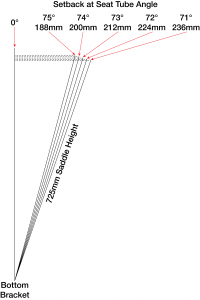Last updated on June 8, 2020
 When I started planning the All-City Electric Queen my main goal was to have a hard tail version of my 2016 Specialized Camber. That is, nice suspension, 120mm of travel in the fork, dropper, and a very similar RAD / RAAD. The only dimension I wanted to change was the seat tube angle, as with the 75° tube on the Camber and I need to position a saddle pretty far back on the rails, even with the 10mm setback on the setback Command Post IRCC.
When I started planning the All-City Electric Queen my main goal was to have a hard tail version of my 2016 Specialized Camber. That is, nice suspension, 120mm of travel in the fork, dropper, and a very similar RAD / RAAD. The only dimension I wanted to change was the seat tube angle, as with the 75° tube on the Camber and I need to position a saddle pretty far back on the rails, even with the 10mm setback on the setback Command Post IRCC.
Unfortunately, I think I went too far.
When comparing geometries I saw the Electric Queen has a 71° seat tube and figured that’d be perfect for moving the saddle back, better centering it in the zero-offset Fox Transfer post. What I failed to do was the sort of calculation shown above to illustrate just how far back the saddle would be moved by every degree of seat tube angle change.
It turns out that, at 725mm of saddle height, every degree of seat tube angle change moves the saddle about 12mm. Thus, on my Camber which has a 75° seat tube, 10mm offset post, and the saddle about 15mm behind centered, I should have been looking for a ~73° seat tube angle in order to roughly center the saddle on a straight (0mm offset) seatpost. Going to a 71° seat tube moved the center point a full 48mm — nearly two inches — rearward.
During single track rides on the Electric Queen I’ve ended up with a sore lower back when pushing, I’m not comfortable at higher cadences, and my stomach brushes my thighs when leaned over and seated. All of this is a sign of the saddle being too far back. With the 71° seat tube angle I simply can’t get the saddle far enough forward: it’s center position is 38mm behind where it is in the Camber (with it’s 10mm offset post). There’s just not enough fore/aft room for adjustment on a saddle to make up for this. When just 5mm or 10mm, especially rearward, makes a difference this isn’t good.
This all then brings about the question: did I buy too large of a frame? The answer is: no, I bought a frame with the wrong seat tube angle for my body.
Fitted forward of the bottom bracket — based on stack and reach — the frame fits properly. Where it doesn’t work is from the bottom bracket to the saddle, all due to the 71° seat tube angle. All of the Electric Queen frames have the same seat tube angle, with the only real variances between sizes being stack, reach, and seat tube length.
The problem is that my body shape (shorter legs, likely shorter femurs specifically, longer torso) not being compatible with this frame.
This consistent 71° seat tube angle, from X-Large all the way down to the X-Small frame, makes me wonder how this frame can fit smaller size riders, unless maybe they have exceptionally long femurs. I wear pants with a 30″ inseam — fairly short but not tiny by any stretch — and my legs seem normally proportioned, so if this setback doesn’t work for me there’s likely a whole bunch of other folks it won’t work for either. Or maybe I just have short femurs?
So, where do I go from here?
I’m going to experiment with some other saddles around home (eg: Specialized Phenom) and see if I can make it fit, but it looks like the only choice for getting a comfortably ridable bike will be another frame with a steeper seat tube angle. On first look it seems like the Ritchey Ultra (Large) or Kona Honzo ST (Medium) would work, with the Ultra having a slight edge in with 73.5° seat tube and taking the same size seatpost as the Electric Queen.